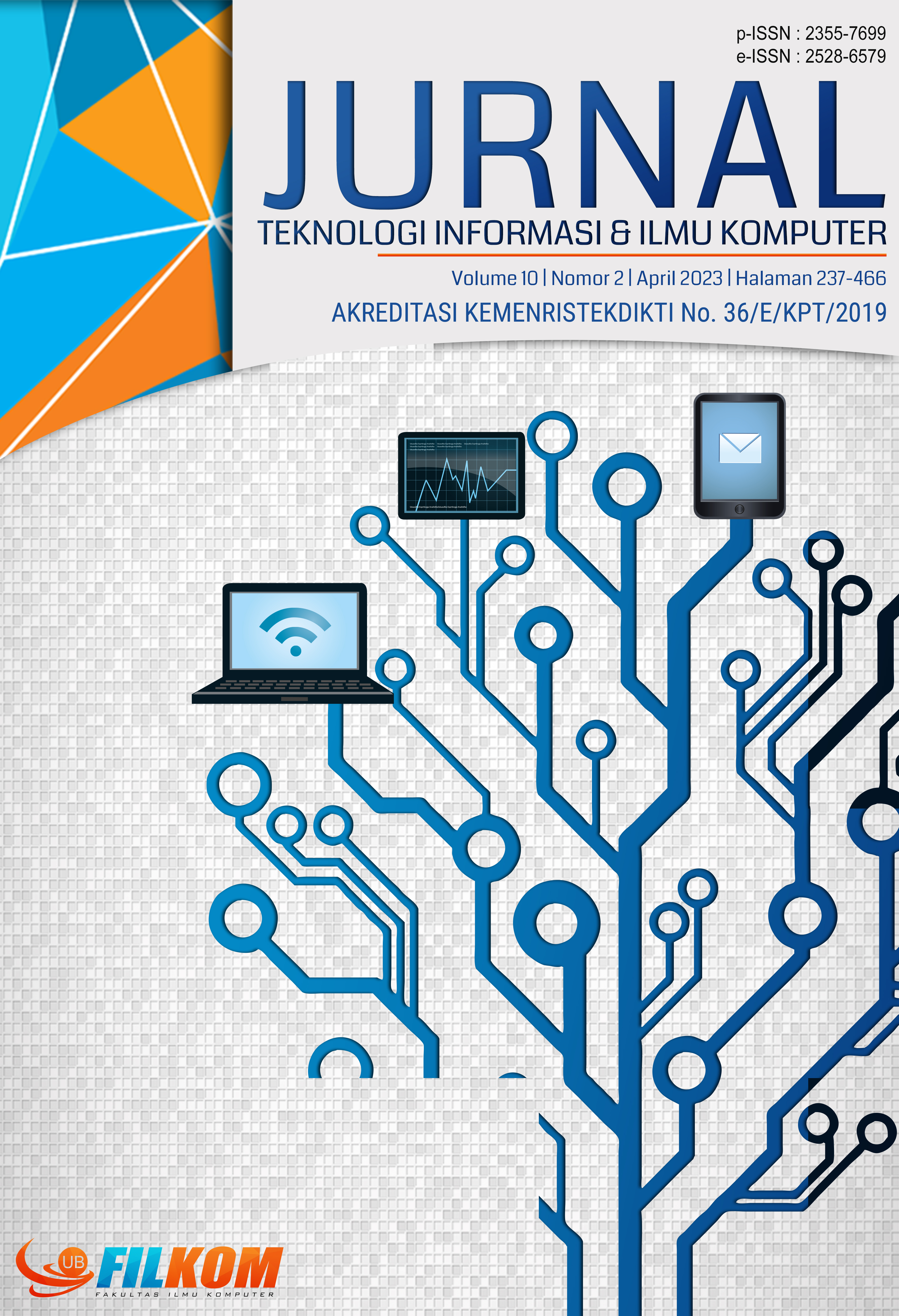Sistem Identifikasi Kesehatan Pencernaan Berdasar Suara Usus Menggunakan Embedded System
DOI:
https://doi.org/10.25126/jtiik.20236515Abstrak
Ileus adalah salah satu penyakit usus yang disebabkan oleh tersumbatnya lumen usus akibat berhentinya gerak peristaltik di dalam usus. Jika tidak ditangani dengan cepat, Ileus bisa menyebabkan usus berlubang. Namun, penderita Ileus seringkali tidak menyadari terjadinya penyakit ini di dalam tubuhnya, sehingga sebaiknya memeriksakan kesehatan pencernaan setiap hari sebagai pencegahan. Oleh karena itu, diperlukan stetoskop digital untuk memberikan jawaban dari hasil auskultasi. Penelitian ini menggunakan stetoskop yang dimodifikasi dengan soundcard yang terhubung dengan raspberry pi dan ditampilkan melalui aplikasi VNC Viewer. Sedangkan Convolutional Neural Network dengan model tensor flow digunakan sebagai metode klasifikasi dan MFCC teknik ekstraksi fiturnya. Sistem merekam dan mendeteksi kehadiran suara perut dengan auskultasi selama 10 detik, dan jika terdeteksi suara perut lebih dari 1 maka dapat disimpulkan pencernaan itu sehat, begitu juga sebaliknya. Dalam penelitian ini, uji klasifikasi untuk yang lain diberi label ‘NIHIL’ suara perut, dan hasil auskultasi adalah 5,85 detik untuk uji klasifikasi. Akurasi yang diperoleh untuk klasifikasi TERDETEKSI' adalah 90%, dan untuk ‘NIHIL’ adalah 100%.
Abstract
Ileus is one intestinal disease caused by the blockage of the bowel lumen due to the cessation of peristalsis within the intestine. If not handled quickly, Ileus could lead to a perforated bowel. However, the sufferer of Ileus often does not realize the occurrence of this disease within his body, so it would be better to check up on the digestive health every day as a preventive. Therefore, a digital stethoscope is needed to provide answers from auscultation results. This study used a modified stethoscope with a soundcard connected to the raspberry pi and displayed through the VNC Viewer application. Meanwhile, Convolutional Neural Network with tensor follow model is used as the classification method and MFCC Technique as the feature extraction. The system records and detects the bowel noise with auscultation for 10 seconds, and if the bowel noise is detected more than1 time, it means normal condition or health, and vice versa. In this study, the classification test for another was labeled with ‘NIHIL,' and the auscultation result was 5.85 seconds for the classification test. The accuracy obtained for the classification of 'digestion-sound' is 90%, and for the 'no digestion sound' is 100%.
Downloads
Referensi
ADITYA DHAVALA, A. A. 2022. An MFCC Features-driven subject-independent Convolution Neural Network for Detection of Chronic and Non-chronic Pulmonary Diseases. 2022 3rd International Conference for Emerging Technology (INCET), Belgaum, India. May 27-29, 2022.
AKSHAT, G. Z. 2018. A Smart Healthcare Monitoring System Using Smartphone Interface. Fourth International Conference on Devices, Circuits and Systems (ICDCS’18), 228-231.
CAPPELL, S. R. 2017. A Systematic Review of the Clinical Presentation, Diagnosis, and Treatment of Small Bowel Obstruction. Curr Gastroenterol Rep (2017) 19: 28, 1-14.
DEWA, C. K. 2016. Javanese Vowels Sound Classification with Convolutional Neural Network. 2016 International Seminar on Intelligent Technology and Its Application, 123-128.
GIL PINHEIRO, P. C. 2019. Small Bowel Mucosa Segmentation For Frame Characterization. 2019 IEEE 16th International Symposium on Biomedical Imaging (ISBI 2019), 83-86.
HALL, J. 2011. Buku Ajar Fisiologi Kedokteran. Philadelphia: Elsevier.
HANJUN JIANG, K. Z. 2020. Long-Term Bowel Sound Monitoring and Segmentation by Wearable Devices and Convolutional Neural Networks. IEEE TRANSACTIONS ON BIOMEDICAL CIRCUITS AND SYSTEMS, VOL. 14, NO. 5, OCTOBER 2020, 985-996.
JAKUB FICEK, K. R. 2021. Analysis of Gastrointestinal Acoustic Activity Using Deep Neural Networks. Sensors 2021, 21, 7602. https://doi.org/10.3390/s21227602, 1-14.
JUZHENG LIU, Y. Y. 2018. Bowel Sound Detection Based on MFCC Feature and LSTM Neural Network. Tsinghua National Laboratory for Info. Sci. & Tech., Inst. of Microelectronics, Tsinghua Univ., Beijing, China.
KANG ZHAO, H. J. 2020. A CNN Based Human Bowel Sound Segment Recognition Algorithm with Reduced Computation Complexity for Wearable Healthcare System. Guangdong Engr. Research Center on ICs for Wireless Healthcare, Research Inst. of Tsinghua Univ. in Shenzhen, China.
KANG ZHAO, S. F. 2022. A Binarized CNN-Based Bowel Sound Recognition Algorithm With Time-Domain Histogram Features for Wearable Healthcare Systems. IEEE TRANSACTIONS ON CIRCUITS AND SYSTEMS—II: EXPRESS BRIEFS, VOL. 69, NO. 2, FEBRUARY 2022, 629-631.
MA, P. 2020. Digital Stethoscope AI.
NASRIN RAZAVIANZADEH, B. F. 2016. Small bowel obstruction attributable to phytobezoar. Oxford Medical Case Reports, 2016;12, 305–308.
T. SUNIL KUMAR, E. S. 2019. Pilot Study of Early Meal Onset Detection from Abdominal Sounds. The 7th IEEE International Conference on E-Health and Bioengineering - EHB 2019.
VRUSHALI GADADE, V. G. 2014. Android Smartphone Based Health Monitoring System. International Journal on Recent and Innovation Trends in Computing and Communication ISSN: 2321-8169, 1721-1725.
YOUXING ZHU, Y. X. 2019. A CNN-based Cleanliness Evaluation for Bowel Preparation in Colonoscopy. 2019 12th International Congress on Image and Signal Processing, BioMedical Engineering and Informatics (CISP-BMEI).
YUE YIN, W. Y. 2015. Bowel Sound Based Digestion State Recognition. Institute of Microelectronics, Tsinghua University.
Unduhan
Diterbitkan
Terbitan
Bagian
Lisensi

Artikel ini berlisensi Creative Common Attribution-ShareAlike 4.0 International (CC BY-SA 4.0)
Penulis yang menerbitkan di jurnal ini menyetujui ketentuan berikut:
- Penulis menyimpan hak cipta dan memberikan jurnal hak penerbitan pertama naskah secara simultan dengan lisensi di bawah Creative Common Attribution-ShareAlike 4.0 International (CC BY-SA 4.0) yang mengizinkan orang lain untuk berbagi pekerjaan dengan sebuah pernyataan kepenulisan pekerjaan dan penerbitan awal di jurnal ini.
- Penulis bisa memasukkan ke dalam penyusunan kontraktual tambahan terpisah untuk distribusi non ekslusif versi kaya terbitan jurnal (contoh: mempostingnya ke repositori institusional atau menerbitkannya dalam sebuah buku), dengan pengakuan penerbitan awalnya di jurnal ini.
- Penulis diizinkan dan didorong untuk mem-posting karya mereka online (contoh: di repositori institusional atau di website mereka) sebelum dan selama proses penyerahan, karena dapat mengarahkan ke pertukaran produktif, seperti halnya sitiran yang lebih awal dan lebih hebat dari karya yang diterbitkan. (Lihat Efek Akses Terbuka).















